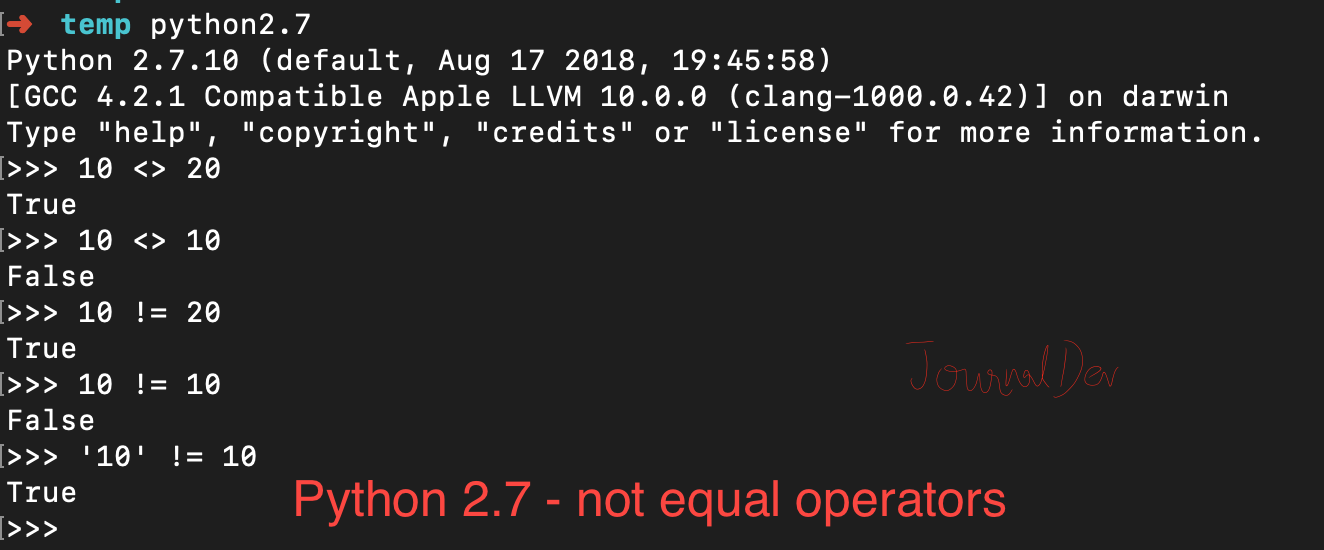Python不等运算符返回True,如果两个变量的类型相同且具有不同的值,则返回True,如果值相同,则返回False。Python是一种动态且强类型的语言,因此如果两个变量具有相同的值但类型不同,则不等运算符将返回True。
Python不等运算符
| Operator | Description |
|---|---|
| != | Not Equal operator, works in both Python 2 and Python 3. |
| <> | Not equal operator in Python 2, deprecated in Python 3. |
Python 2 示例
让我们看一些Python 2.7中不等运算符的示例。
$ python2.7
Python 2.7.10 (default, Aug 17 2018, 19:45:58)
[GCC 4.2.1 Compatible Apple LLVM 10.0.0 (clang-1000.0.42)] on darwin
Type "help", "copyright", "credits" or "license" for more information.
>>> 10 <> 20
True
>>> 10 <> 10
False
>>> 10 != 20
True
>>> 10 != 10
False
>>> '10' != 10
True
>>>

Python 3 示例
这里是一些在Python 3控制台中的示例。
$ python3.7
Python 3.7.0 (v3.7.0:1bf9cc5093, Jun 26 2018, 23:26:24)
[Clang 6.0 (clang-600.0.57)] on darwin
Type "help", "copyright", "credits" or "license" for more information.
>>> 10 <> 20
File "<stdin>", line 1
10 <> 20
^
SyntaxError: invalid syntax
>>> 10 != 20
True
>>> 10 != 10
False
>>> '10' != 10
True
>>>
 如果您使用的是Python 3.6或更高版本,我们也可以在f-strings中使用Python不等运算符。
如果您使用的是Python 3.6或更高版本,我们也可以在f-strings中使用Python不等运算符。
x = 10
y = 10
z = 20
print(f'x is not equal to y = {x!=y}')
flag = x != z
print(f'x is not equal to z = {flag}')
# python is strongly typed language
s = '10'
print(f'x is not equal to s = {x!=s}')
输出:
x is not equal to y = False
x is not equal to z = True
x is not equal to s = True
Python不等于自定义对象
当我们使用不等运算符时,它调用__ne__(self, other)函数。因此,我们可以为对象定义自定义实现,并改变其自然输出。假设我们有一个包含字段id和record的Data类。当我们使用不等运算符时,我们只想比较record值。我们可以通过实现自己的__ne__()函数来实现这一点。
class Data:
id = 0
record = ''
def __init__(self, i, s):
self.id = i
self.record = s
def __ne__(self, other):
# 如果类型不同,则返回True
if type(other) != type(self):
return True
if self.record != other.record:
return True
else:
return False
d1 = Data(1, 'Java')
d2 = Data(2, 'Java')
d3 = Data(3, 'Python')
print(d1 != d2)
print(d2 != d3)
输出:
False
True
请注意,d1和d2的record值相同,但”id”不同。如果我们移除__ne__()函数,则输出将如下所示:
True
True
您可以从我们的GitHub存储库中查看完整的Python脚本和更多Python示例。
Source:
https://www.digitalocean.com/community/tutorials/python-not-equal-operator













